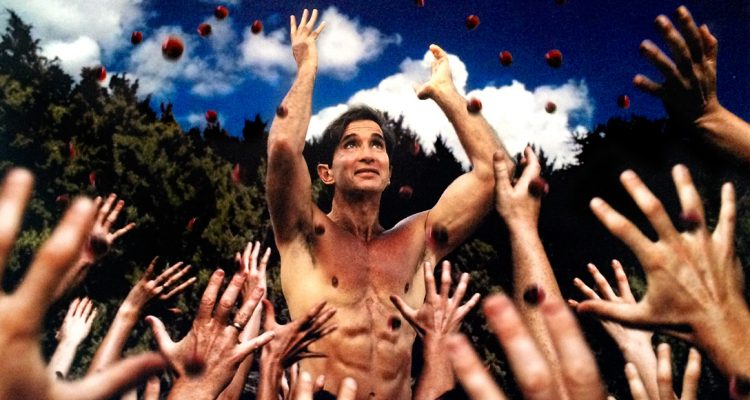After escaping a 20-year stint in a cult, one hopes to salvage something from the experience — lessons learned, a better understanding of human nature, a new direction in life. If making a film about a cult, one hopes to have access to the cult’s videographer. As a former member and videographer of the group The Buddhafield, Will Allen is in the unique position to make a film, “Holy Hell,” that revives his filmmaking career with the wealth of footage he shot during his years in the group. The result is a fascinating and intimate look into life within this congregation, and how cults can have such a strong pull. With unprecedented access to archival footage and former members of The Buddhafield, it’s impossible to look away from “Holy Hell.”
Allen came to the group after graduating from film school. His older sister, a member, encouraged him to join, and they later recruited their younger sister. Raised Catholic in Texas, the siblings were searching for spiritual answers and acceptance from a family more flexible than their conservative parents (Allen’s sexuality was a point of contention with his mother). The Los Angeles-based mediation and self-help group seemed to be the perfect fit. Their journey with The Buddhafield lasted from the mid-1980s to 2007, when Allen finally found the motivation to sever ties.
One of the obstacles with a film of this nature is getting past the audience’s obvious question — why would anyone join a cult? Demonstrating the attraction and subsequent immersion into this cult is where “Holy Hell” excels. Perhaps it’s just the yoga-practicing, essential oil-using, crystal-owning Los Angeleno in me, but for the first first thirty to forty minutes of the film, all I could think was, “Where do I sign up?”
Through the lens of Allen’s camera, The Buddhafield appears to be a Club Med-esque group of lithe, tanned, and beautiful youths frolicking gleefully around the natural landscapes of Southern California and Hawaii: an endless parade of bikinis, fruit salads, singing, and dancing in the woods, bolstered by ballet classes, community service, and an indelible sense of chosen family. The group members seem high off their own supply of sunshine, raw foods, and friendship. What could possibly be wrong with this scenario?
Soon you realize that they’re all being hypnotized by the group’s mysterious and mysteriously beautiful leader Michel, a former actor of questionable provenance, whose career peaked with a non-speaking role in “Rosemary’s Baby.” With piercing eyes and a sculpted bod that he parades around in Speedos, he powerfully controls his followers with a mixture of hypnotherapy, meditation, high expectations, and wooded retreats in which he tempts them with opportunities to receive what he calls “The Knowing,” a concept of spiritual enlightenment cribbed from Buddhism.
Though no one believes they’re in a cult, and Michel claims anyone can come and go as they please, the second the Cult Awareness Network is notified, he changes his name to Andreas and relocates the group from Los Angeles to Austin, Texas, where everything eventually starts to go downhill. In between plastic surgeries and elaborate ballet productions, Michel/Andreas tightens his grip of control on the members, who are starting to realize that some of his practices are downright abusive.
Allen, a film student who found the group through his sister, put his career on hold to devote himself to Michel/Andreas, but threw himself into producing bizarre and campy music videos, ads and testimonials, capturing the rituals and spiritual fervor, the building of the group’s Texas compound, and more. This archival footage is the truly mesmerizing aspect of “Holy Hell,” and the best access we have to understanding the draw of Andreas/Michel and his dynamic with his followers. Interviews with former group members, including Allen’s sisters, are raw and nakedly emotional. Sometimes the members break the fourth wall, speaking to Will behind the camera directly.
Allen keeps the focus tightly on The Buddhafield, and rarely strays to the larger cultural landscape of American cults. There’s a reference to David Koresh and the FBI raid of the Branch Davidians in Waco, only because of the proximity to the cult’s Austin headquarters, and Andreas/Michel’s desire to keep the group under the radar and away from prying governmental eyes.
The group is too small to have the same kind of far reaching power as Scientology, but members of both groups seem to be motivated by a similar search for alternative methods of self-help and spirituality. While the close-up look at the techniques of mind-control and brainwashing enacted on a smaller scale is fascinating, “Holy Hell” seems to have missed an opportunity to connect the experience to other groups of this kind. As Andreas/Michel reinvents himself as Reyji and continues to find followers, it’s clear that there are people who continue to look for life’s spiritual answers from anyone who offers them convincingly enough.
Much of the archival footage in “Holy Hell” is jaw-dropping, but somehow, nothing chills to the bone quite like the last music video Allen made, of members dancing in fields, laughing and crying to the tune of Snow Patrol’s “Chasing Cars.” I’m not sure if it’s the visuals, the earnest song lyrics or the text indicating which members left and which stayed, but it’s one of the most hair-raising sequences of the movie.
While “Holy Hell” only offers answers about this particular group and the experiences of these individuals, it’s a riveting piece of work, a look into a tightly-controlled and private world of brainwashing, abuse and exploitation in the name of spiritual fulfillment. Despite those traumas, many of these people, clear-eyed, and on the other side, are vocally grateful for at least one thing they gained in The Buddhafield—each other. [B+]

